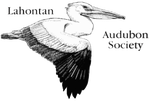|
Written by Olivia Sembach There is a slice of cattle country nestled within the Sparks industrial district where open country farmland birds and other wildlife can find refuge from the hustle and bustle of urban activity. The area contains prime farmland, extending along the Truckee River, and sits just West of Steamboat Creek. The University’s agricultural fields have a wide diversity of surrounding habitats that attract various birds year-round. I have worked as a ranchhand here for the past year and a half while I finish up school at UNR. Working here has given me the ability to observe and learn about wildlife such as mule deer, yellow-bellied marmots, coyotes, bats, beavers, insects, fish, birds, and more birds, to name a few. All photos taken by Olivia Sembach on the University Farms If you are looking for a safe, easy, and enjoyable car or bike-friendly birding trip, the University farms is a great option. Fall and winter are my favorite times of the year to bird here; waterfowl, sparrows and raptors are abundant this time of year. The Canada Geese come in flocks of hundreds. In the larger flocks, Cackling Geese, Snow Geese, and Greater White-Fronted Geese are regulars, but they can be hard to spot in a Canada Geese blackout. Winter is the best time to view raptors here. Over the past couple of weeks, I have noticed a massive increase in raptor populations. In early November, I witnessed multiple battles between raptors for hunting territory. The most remarkable war between an American Kestrel and two Prairie Falcons; all three were diving and swooping at each other, just as falcons do. The battle ended in the two Prairie Falcons perching together on a nearby telephone pole while the kestrel took off to another field. Keep an eye out for other raptors such as the Peregrine Falcon, Red-tailed Hawk, Northern Harrier, Cooper’s Hawk, Ferruginous Hawk, and Bald Eagle to name a few. In the summer, the insect populations support many different species of birds. One of my favorite birds that breed on the farm is the Bullock’s Oriole. Check the cottonwoods and other trees for their nests. Once all the leaves have fallen in the winter, you can see their intricately weaved pendant nests hanging from the branches. Throughout summer, Western Kingbirds and Say's Phoebes, are plentiful and often perch along the fences swooping for bugs. Besides the cattle and sheep, the farm is well known for its large populations of yellow-bellied marmots. Marmot activity is at its peak in the spring and early summer. After watching their curious and hilarious behaviors, I now consider myself a “marmot-watcher.” The young marmots will wrestle and play with their siblings, all while I stand less than ten feet away from them. I couldn’t get enough of it in the spring. They will even hang by their front legs on the fence that runs along the irrigation ditch, just peeping over into the water. Once summer hits and it gets too hot, the marmots go in their burrows for the rest of the year. This fall, one single marmot came out of his burrow to forage every day if the weather permitted. He has been the only marmot that remained active throughout the fall, making me curious why others aren’t active. The farm is also home to a few small resident populations of mule deer easily spotted from the road. They are usually in the fields adjacent to the river, but they often wander into other areas. If you see a deer that appears to have an injured or a broken leg, do not worry, that is “Broken Leg Deer,” as we call her, and she has been living with an injured leg since before I started working on the farm. These fields and the surrounding habitats have existed since 1958, giving wildlife a stable source of habitat and water in the summer months. Lots of critters have come to rely on these resources due to their stability. The never-ending development in the Reno-Sparks area forces wildlife to the edges of their habitat, leaving them no choice but to find new territories. Luckily, the University farms can provide some of these animals a safe place to sleep and eat. For those in need of a quick escape from urban Reno/Sparks to view wildlife, the University farms are a great option. The accessibility by car and bike makes it ideal for sensitive populations or those who just want to see unique wildlife. Check out the University Farms Area Birding Guide for more birding information on this location. |
topics
All
Archives
July 2024
|


 RSS Feed
RSS Feed